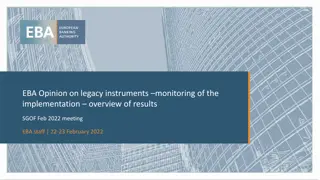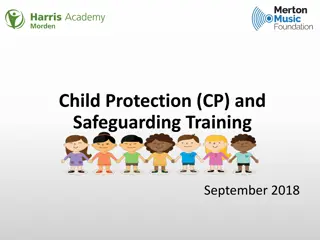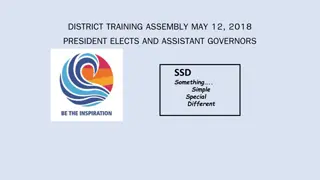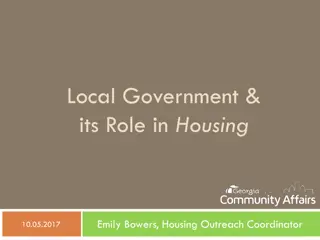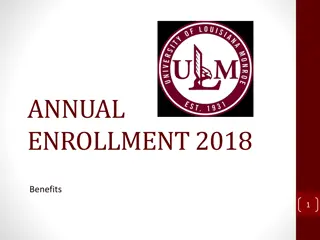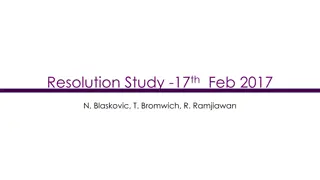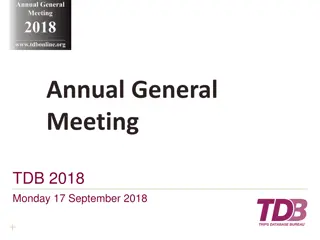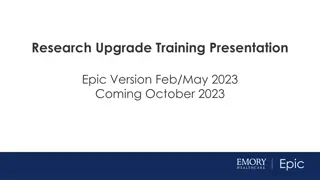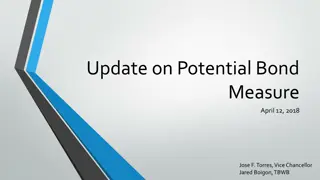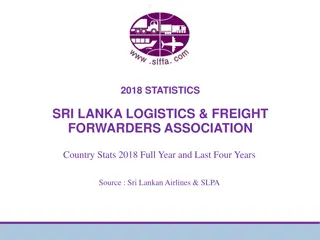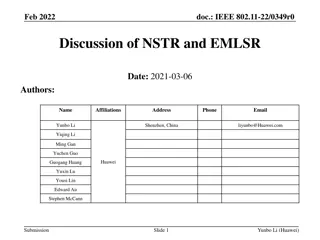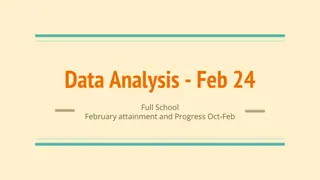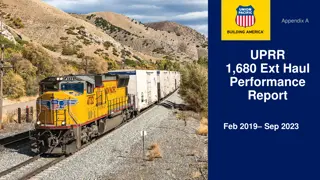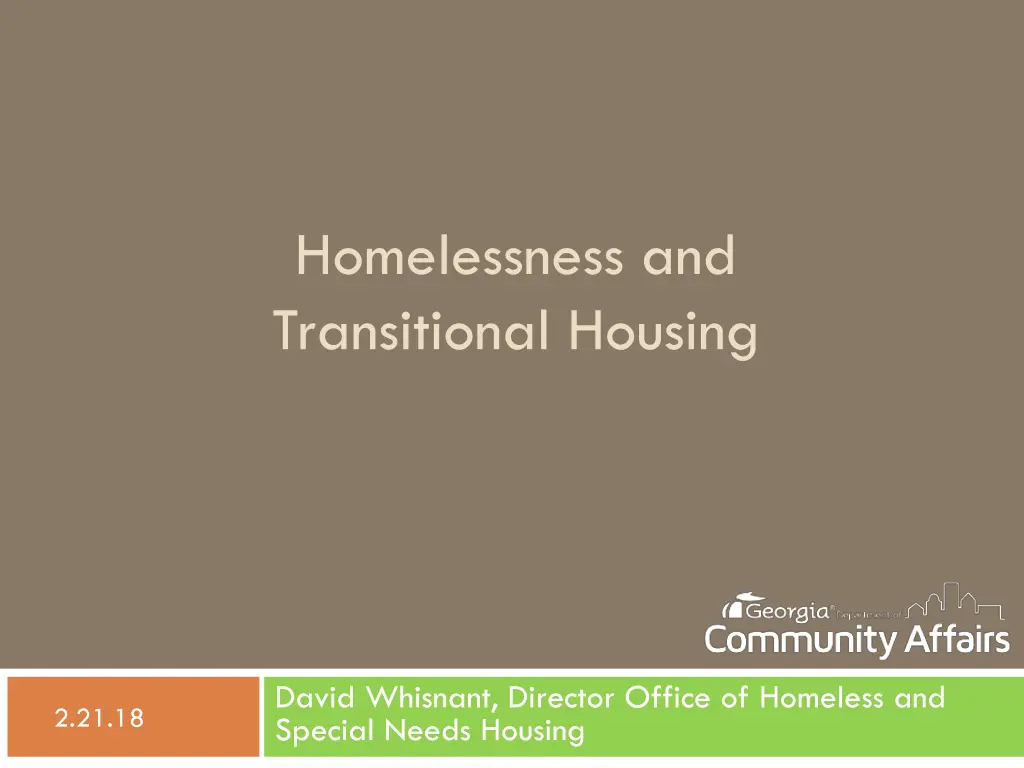
Understanding Homelessness: Myths and Realities
Exploring the various misconceptions about homelessness, including drug abuse, work opportunities, affordable housing challenges, and the true demographics of the homeless population. Learn about the complexities of homelessness and the need for more support and resources.
Download Presentation

Please find below an Image/Link to download the presentation.
The content on the website is provided AS IS for your information and personal use only. It may not be sold, licensed, or shared on other websites without obtaining consent from the author. If you encounter any issues during the download, it is possible that the publisher has removed the file from their server.
You are allowed to download the files provided on this website for personal or commercial use, subject to the condition that they are used lawfully. All files are the property of their respective owners.
The content on the website is provided AS IS for your information and personal use only. It may not be sold, licensed, or shared on other websites without obtaining consent from the author.
E N D
Presentation Transcript
Homelessness and Transitional Housing David Whisnant, Director Office of Homeless and Special Needs Housing 2.21.18
Introduction My experience in working with the Homeless Tale of the Waffle House Breakfast Georgia Municipal Association
Who is Homeless? Do you think that this is a good snapshot? Drug Addicts Mentally Ill Lazy Choose this Lifestyle/Refuse Assistance Just need to get a job Or, don t work Under a bridge
Homeless Facts: Everyone is Using Drugs . Although obtaining an accurate, recent count is difficult, the Substance Abuse and Mental Health Services Administration (2003) estimates, roughly 74% of the homeless do not abuse drugs. (Didenko and Pankratz, 2007).
Homeless Facts: Get a Job! According to a national study by the Urban Institute, about 45 percent of homeless adults had worked in the past 30 days -- only 14 percentage points lower than the employment rate for the general population last month. The number of working homeless would probably be even higher if "off the books" work was included. Whether scavenging for scrap metal or staffing shelters, many homeless people adopt ingenious ways to subsist. Minimum Wage: $7.25 X 160 hours a month = $1,160 per month. In 2013, more than 80 percent of households with federal minimum-wage incomes ($15,000 or less per year) were cost-burdened, or spending more than 30 percent of household income on rent. When households are cost-burdened, they re forced to cut back on other basic needs, such as food, transportation, and health care. Been to a Panera or McDonalds? Homeless helped you! The Work or Sleep Dilemna
Homeless Facts: Got Housing? There are fewer places for poor people to rent than before. According to the NLCHP, one eighth of the nation s supply of low-income housing has been permanently lost since 2001. The U.S. needs at least 7 million more affordable apartments for low-income families, and as a result, millions of families spend more than half of their monthly income on rent. There is not enough public rental assistance. Resources allow about one out of every four extremely low-income households to receive assistance. Those who do not receive help are on multi-year waiting lists. For example, Charlotte just opened up their applications for public housing assistance for the first time in 14 years, and over 10,000 people applied. There are fewer places for poor people to rent than before. According to the NLCHP, one eighth of the nation s supply of low-income housing has been permanently lost since 2001. The U.S. needs at least 7 million more affordable apartments for low-income families, and as a result, millions of families spend more than half of their monthly income on rent.
Homelessness Facts: Women and Children One quarter of homeless people are children. HUD reports that on any given night, over 138,000 of the homeless in the U.S. are children under the age of 18. Thousands of these homeless children are unaccompanied, according to HUD. Another federal program, No Child Left Behind, defines homeless children more broadly and includes not just those living in shelters or transitional housing but those who are sharing the housing of other persons due to economic hardship; living in cars, parks, bus or train stations; or awaiting foster-care placement. Under this definition, the National Center for Homeless Education reported in September 2014 that local school districts reported there are over 1 million homeless children in public schools. Domestic violence is a leading cause of homelessness among women. According to the National Law Center on Homelessness and Poverty (NLCHP), more than 90 percent of homeless women are victims of severe physical or sexual abuse, and escaping that abuse is a leading cause of their homelessness.
How Big is the Problem? Point in Time Count (PIT) The Point-in-Time (PIT) count is a HUD required count of sheltered and unsheltered homeless persons on a single night in January. Each count is planned, coordinated, and carried out locally. HUD requires an annual count be made of homeless persons who are sheltered in emergency shelter, transitional housing, and Safe Havens on a single night. HUD requires a count of unsheltered homeless persons every other year (odd numbered years). 2019 is the next required unsheltered count. How the Count is done
HUDS Definition of Homelessness In accordance with HUD guidelines, for the 2017 Count, the focus is on the literally homeless: Sheltered Example: In an emergency shelter, or transitional housing for homeless persons Unsheltered Example: A hotel or motel with the stay being paid for by an organization, or in a car, park, abandoned building, encampment, dilapidated building, on the sidewalk, or similar location The count does leave out people who are couch surfing or others commonly thought of as homeless. The HUD definition controls.
Georgias 10,000 Georgia s Literally Homeless Population: Single Night (Point in Time Count) Number of Individuals per Year Housing Status 2013 2015 2017 Unsheltered 8,450 5,803 3,692 Emergency Shelter or Transitional Housing 8,497 7,987 6,681 Total 16,947 13,790 10,373 Change from previous count (%) -15% -19% -25%
Georgias 10,000 2011-2017 Point in Time Homeless Count Trend 25000 19876 20000 16947 15000 13790 10373 10000 5000 0 2011 2013 2015 2017
Georgias 10,000 Sheltered and Unsheltered Homeless Counts 2011 through 2017 12000 11384 10000 8000 8450 6000 5803 4000 3692 2000 0 2011 2013 2015 2017 Sheltered Unsheltered
Georgias 10,000 -- Veterans 726 homeless persons in Georgia on the night of the count were veterans In 2015, there were 1,546 homeless veterans in Georgia on the night of the count
GAs 10,000 Chronically Homeless Ten percent (10%) of the homeless population was experiencing chronic homelessness on the night of the count. Chronic homelessness is defined as someone experiencing continuous homelessness for at least one year or at least 4 times in the past 3 years with their total time in shelters or on the street adding up to over 1 year and who has a disabling condition.
Americas Numbers vs. Georgias In total, 33 states and the District of Columbia (D.C.) reported decreases in overall homelessness, while 16 states reported increases. The states with decreases in homelessness were concentrated in the South and Midwest. Despite a national decrease in unsheltered homelessness, only 18 states reported decreases in the number of people living in unsheltered locations, including the street, cars and abandoned buildings. The national decrease in unsheltered homelessness was driven in large part by decreases in unsheltered homelessness in Florida, Texas and Georgia. The national rate of homelessness in 2015 fell to 17.7 homeless people per 10,000 people in the general population from 18.3 in 2014. The rates in individual states ranged from 111 in the D.C. to 7 in Mississippi. GA=10.0 The rate of veteran homelessness continued its descent of the past several years to 24.8 homeless veterans per 10,000 veterans in the general population. The rates in individual states ranged from 145 in D.C. to 9 in Virginia. GA=11.32 The majority of states had decreases in every major subpopulation: family homelessness (33 states and D.C.), chronically homeless individuals (31 states and D.C.) and veteran homelessness (33 states). Source: 2016 State of Homelessness Report, National Alliance to End Homelessness
Why are the Numbers Down? Emphasis on Rapid Rehousing vs. Housing Ready ; Shelter stays are brief, not designed for long term; Increased emphasis by HUD on increasing income as performance measure; Changes in count methodology; Moving away from Transitional Housing; Prioritization by HUD for veterans, and chronic homeless The economy is better There still is a huge problem that requires tremendous resources
But, We Cant Afford To Help! Fiscal Impacts of Homelessness Health Care: Homeless persons are more likely to use the most expensive health care interventions, such as emergency rooms. Homeless people spend on average four more days per hospital visit than comparable non-homeless people, at a cost of approximately $2,414 per hospitalization. Homelessness frequently results from and aggravates serious health care problems, including addiction. Attempts to treat people who do not have stable housing are ineffective and costly. Heart Disease Homeless persons spend much time in jail or prison, often for petty crimes. It is not unusual for homeless people to continue to commit minor offenses so that they can return to the relative safety and warmth of a jail cell. The typical cost of a prison bed in a state or federal facility is $20,000 per year, compared to a typical annual rent subsidy of about $4,500-$6,000. Compromised health and time in jail limit homeless people's employability, and create long-term reliance on welfare systems. Stealing Ho Hos Emergency shelter is the most immediate and basic response to homelessness. However, emergency shelter is the least cost-effective approach to solving the need for long-term housing. With an average annual cost of $15,000 for singles and $25,000-$30,000 for families, emergency housing is far more expensive and less effective than the typical annual rent subsidy of $4,500-$6,000 per unit.
Actual Figures for What Different Counties Cost the System If we assume that based on national literature the cost for each homeless person is around $3,000 per month to the system . Bibb County 310 persons = $930,000 MONTHLY Barrow County 64 persons = $192,000 MONTHLY Floyd County 62 persons = $186,000 MONTHLY Effingham County 22 persons = $66,000 MONTHLY Gordon County 31 persons = $93,000 MONTHLY Liberty County 42 persons = $126,000 MONTHLY Coffee County 16 persons = $48,000 MONTHLY
Truth We re All Paying for Homelessness, RIGHT NOW. But, as we will see, for less money we can get greater results! Difficulty is often quantifying costs, as they are across many different areas
HUD Goals HUD has shown a recent commitment to identifying specific populations to focus federal efforts and resources on. Examples: Chronic Homeless Homeless Veterans Homeless Youth (next big focus)
HUDs GOALS Housing Stability through Housing First What is Housing First? Housing First is a homeless assistance approach that prioritizes providing permanent housing to people experiencing homelessness, thus ending their homelessness and serving as a platform from which they can pursue personal goals and improve their quality of life. This approach is guided by the belief that people need basic necessities like food and a place to live before attending to anything less critical, such as getting a job, budgeting properly, or attending to substance use issues. Additionally, Housing First is based on the theory that client choice is valuable in housing selection and supportive service participation, and that exercising that choice is likely to make a client more successful in remaining housed and improving their life.
Does Housing First Work? Consumers in a Housing First model access housing faster and are more likely to remain stably housed. This is true for both PSH and rapid re-housing programs. PSH has a long-term housing retention rate of up to 98 percent. Studies have shown that rapid re-housing helps people exit homelessness quickly in one study, an average of two months and remain housed. A variety of studies have shown that between 75 percent and 91 percent of households remain housed a year after being rapidly re- housed.
Housing First Saves Money Providing access to housing generally results in cost savings for communities because housed people are less likely to use emergency services, including hospitals, jails, and emergency shelter, than those who are homeless. One study found an average cost savings on emergency services of $31,545 per person housed in a Housing First program over the course of two years. Another study showed that a Housing First program could cost up to $23,000 less per consumer per year than a shelter program. Other studies have come back with even higher numbers.
Where Does Transitional Housing Fit? What is it? Current Role Under HUD? Costs State Funding
Harm Reduction HUD Endorses Harm Reduction What is Harm Reduction, and How Does That Apply to Housing First? What it is not, and common misunderstandings
DATA: The New World Of Evaluating Services for the Homeless
Data For Dollars Old Go forth and do great things! New Prove those great things with numbers! Grantsmanship 2.0 What s an HMIS system?
HUDS Performance Measures Measure 1: The Length of Time Persons Remain Homeless Measure 2: The Extent to which Persons who Exit Homelessness to Permanent Housing Destinations Return to Homelessness Measure 3: Number of Homeless Persons Measure 4: Employment and Income Growth for Homeless Persons in CoC Program-funded Projects Measure 5: Number of Persons who Become Homeless for the First Time Measure 6: Homeless Prevention and Housing Placement of Persons Defined by Category 3 of HUD s Homeless Definition in CoC Program- funded Projects Measure 7: Successful Placement from Street Outreach and Successful Placement in or Retention of Permanent Housing Agencies and Communities Now Must SHOW RESULTS!
American Planning Association Says: Planners should work to ensure that local comprehensive plans include housing elements that provide for a diverse choice of housing opportunities, in all price ranges, distributed throughout the community and for inclusion of appropriate types of supportive housing in amounts consistent with demonstrated need. Local Planners should encourage the specific subject of homelessness in local comprehensive plans.
Taking Charge of Homelessness In Your Community Planners should ensure that local comprehensive plans address the need for a wide array of emergency, transitional, and permanent housing to serve the homeless, including rental units for households with incomes below 30 percent of area median income (See APA Policy Guide on Housing, 1999). Planners should work to ensure that every community has reasonable facilities to accommodate the needs of the homeless on a short-term or emergency basis. Tip: No facilities? Jot down ESG funding and hotel/motel vouchers and rapid rehousing. Tip: Even if you have shelters, low barrier/high barrier? Tip: What can government do to educate landlords?
Taking Charge of Homelessness In Your Community Local Planners should encourage coordination between the general planning/land use departments with community development and/or human service funding agencies and nonprofits. Specifically, planners should identify and cross reference common goals or related objectives in local land use plans with federally mandated housing and community development plans and strategies (i.e.: HUD Consolidated Plans, Neighborhood Revitalization Strategies, and Continuum of Care Strategies.) Obstacle: But, we don t have a problem!
Understanding The Landscape Before we can talk about the programs, we need to understand how the planning and decision making is arranged for the programs. CoC= Continuum of Care ESG=Emergency Solutions Grant
CoC Funding CoC Program Common Uses of Funds: Shelter Plus Care Permanent Supportive Housing Rapid Rehousing Supportive Services (Few CoCs) YES, Local Governments Can Apply!
CoC: Local Planning for Local Needs Why we have CoCs: HUD Can t Decide Alone There are nine (9) Continua of Care in Georgia. (1) Athens/Clarke, (2) Augusta/Richmond, (3) Columbus/Muscogee, the City of (4) Atlanta, and the counties of (5) Chatham (including Savannah), (6) Cobb, (7) DeKalb, and (8) Fulton (excluding Atlanta). The ninth (9th) continuum, the Georgia's Balance of State Continuum of Care (BoS CoC), is composed of representatives of relevant organizations organized within 152 of Georgia's 159 counties. Each CoC is responsible for various tasks under HUD, including conducting the annual funding competition for CoC program funds, conducting a point in time count survey, and creating governance and systems to coordinate effectively within the geographic area to provide services to homeless persons.
CoC Funding 2018 Results By State January 11, 2018 HUD announced over $2 billion to more than 7,300 local homeless housing and service programs across the U.S. and Guam 185 Programs in Georgia for $41,017,540 Alabama: $17,752,162 Florida: $83,226,614 South Carolina: $9,954,311 North Carolina: $25,573,629
CoC Funding By CoC Balance of State (DCA)(152 Counties): $17,970,632 Atlanta: $7,244,948 Fulton: $2,570,781 Athens/Clarke: $729,515 Augusta: $645,136 Columbus: $1,401,337 Marietta/Cobb: $2,200,978 Savannah: $3,251,372 DeKalb: $5,002,841
Application Process Applications are accepted through your Continuum of Care. Dates are not set for the competition beginning and end. Typically, the period begins in July and ends in September. All CoCs do application workshops. Start talking to your CoC NOW if interested. New programs are sometimes unveiled in each year s competition
Emergency Solutions Grants Program ESG Eligible Programs: Outreach Emergency Shelter Hotel/Motel Voucher Rapid Re-housing Homeless Prevention Supportive Services YES, Local Governments Can Apply!
Application Process Each year, typically in mid to late February, the State of Georgia opens a competitive application process for the Emergency Solutions Grants (ESG), Housing Opportunities for Persons with AIDS (HOPWA), Shelter Plus Care Matching, and Shelter Plus Care Harm Reduction programs. For this fiscal year, we received 224 requests totaling $13.8 million across all four programs. Of the requests, $8.7 million was awarded to 155 programs. Match: Leverage Those Dollars! 100% required.
Layer your ESG Funding! DCA can fund programs in ALL areas of the state. Are you in your own entitlement area? If so, you can use those funds and the DCA competition funds! There are nine ESG Entitlement areas/communities in Georgia. They are: Atlanta, Augusta-Richmond, Macon-Bibb, Savannah-Chatham, Clayton County, Cobb County, DeKalb County, Fulton County, and Gwinnett County, and the DCA Entitlement, which covers all areas of the State not covered by one of the other ESG Entitlements. Each entitlement conducts their own competition. The DCA Entitlement funds state-wide, with most monies being reserved for the entitlement.
Ideas for how to be involved Apply and provide services directly Apply and distribute funds in your community Provide match for agencies in your area Provide in kind resources for agencies in your area such as office space Work with community partners to raise match for agencies Contribute funds to support activities of grantees in your area where federal funds don t cover
We Would Like To Fund You! Calling all City and County Governments! Provide services directly, or grant to non- profits in your area. (They can make match). We would love to talk to you about your needs and what programs could help solve the problems in your community. Bonus points for applicants within our state entitlement area (ESG).
City of Hinesville -- ESG Rapid Rehousing: $30,000 Hotel/Motel Vouchers: $50,000 Prevention: $30,000
City of Albany -- ESG Rapid Rehousing: $40,000
Coordinated Entry Each CoC Must Have a Coordinated Entry System for Homeless Services Coordinated Entry was Mandated by HUD for All CoCs as of January, 2018 Each CoC Organizes Their Own You now know what CoC you fall in!
What the Heck Is Coordinated Entry? Coordinated Entry is a process through which people experiencing homelessness access the crisis response system in a streamlined way, have their strengths and needs quickly assessed, and are quickly connected to appropriate, tailored housing and mainstream services within the community or designated region.
Coordinated Entry in BoS (152 Counties) 4 Implementation Sites (Bartow, Bibb, Colquitt, Liberty) These sites are doing outreach to educate their communities on how to access the CES locally Individuals and families experiencing literal homelessness can access services by calling or visiting the CES access points in these communities In the future, implementation sites will grow to cover multiple counties We are working on a second wave of implementation sites to include Gwinnett, Hall, Troup, Glynn, Douglas and Dougherty counties. The BoS will continue to strategically expand implementation sites and grow each site to cover a multi-county region. LOCAL GOVERNMENT IS HEAVILY INVOLVED IN THESE IMPLEMENTATIONS Each Implementation is shaped by LOCAL needs and requirements
BoS Areas Outside Implementation Communities Funded agencies that are not currently in a community with a CES implementation are required to assess individuals and families experiencing literal homelessness and prioritize federally funded homeless resources on an agency level. Additionally, the BoS will have a toll-free hotline that anyone in any part of the state can call to be quickly assessed, using the prevention and diversion screening tool, and connected to funded agencies in their area for emergency shelter or housing assistance. CoC staff will be tracking the referrals made by the hotline and ensure that agencies follow up with the individuals or families.

